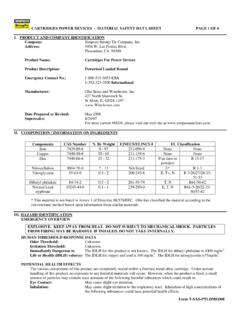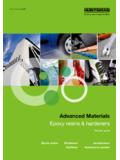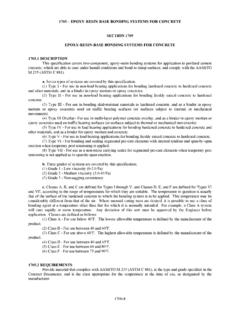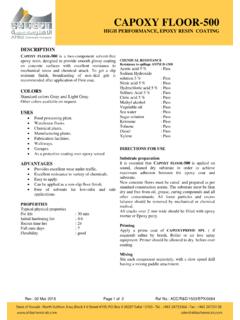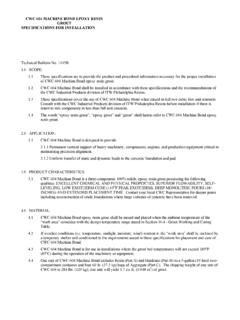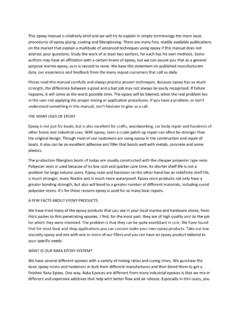Transcription of ITW Devcon Material Safety Data Sheet 5-MINUTE …
1 MANUFACTURERITW Devcon30 Endicott , MA 01923 Emergency telephone number (800) 424-9300(CHEMTREC): Other Calls: (978) 777-1100 EMERGENCY INFORMATION5-MINUTE EPOXY RESINP rinted: 7/2/20042. COMPOSITION/INFORMATION ON INGREDIENTS"TLV" means the Threshold Limit Value exposure (eight-hour, time-weighted average, unless otherwise noted) established by the AmericanConference of Governmental Industrial Hygienists. "STEL" indicates a short-term exposure limit. "PEL" indicates the OSHA Permissible ExposureLimit."n/e" indicates that no exposure limit has been established. An asterisk (*) indicates a substance whose identity is a trade secret of our supplier and unknown to revised: 06/10/04 HAZARDOUS CONSTITUENTSE mergency OverviewWARNING! Eye and skin irritant. Potential skin HAZARDS IDENTIFICATIONA ppearance, form, odor:Clear viscous liquid with little 1427014270G 14630DA007 DA032 DA051 DA208 DA275 VC018 This product appears in the following stock number(s):ConstituentACGIH TLVCAS percentOSHAPELO ther A diglycidyl ether resin25068386>60n/en/eDGEBPAn/eEyes: Moderate irritant (stinging, burning sensation, tearing, redness, swelling).
2 Contact at elevated temperatures cancause thermal burns which may result in permanent damage or health effectsSkin: Moderate irritant. Contact at elevated temperatures can cause thermal burns which may result in permanentdamage. May cause skin sensitization (itching, redness, rashes, hives, burning, swelling).Symptoms of acute overexposure:Skin contactSkin absorptionEye contactInhalationIngestionPrimary routes of exposure:Exposure limits1. CHEMICAL PRODUCT AND COMPANY IDENTIFICATIONT radename: 5-MINUTE EPOXY RESING eneral use:This information applies to the resin component of the two-part kit; handle freshly-mixed resin andhardener as recommended for the hardener. After curing, the product is not family: Epoxy resinProduct Identifier: EPOXY RESINMSDS0619 ITW DevconMaterial Safety data Sheet Page 1 Part No.: 1233 Unusual fire and explosion hazards: Heating above 300 deg F in the presence of air may cause slow oxidative decomposition and above 500 deg F maycause polymerization.
3 Personnel in vicinity and downwind should be products of combustion:When heated to decomposition it emits fumes of Cl- , carbon monoxide, other fumes and vapors varying incomposition and dioxideDry chemicalFoamAlcohol foamWaterExtinguishing media:Flash Point ( F): >400 Method: PMCCE xplosive limits in air (percent) -- Lower: n/dUpper:n/dSpecial firefighting procedures: Material will not burn unless preheated. Do not enter confined space without full bunker gear. Firefighters shouldwear self-contained breathing apparatus and protective clothing. Cool fire exposed containers with FIRE FIGHTING MEASURESF irst aid for skin: Immediately remove contaminated clothing and excess contaminant. Flush skin with water for at least 15 thoroughly with soap and warm water. Consult a physician if irritation aid for ingestion: Do NOT induce vomiting unless directed by medical personnel.
4 Rinse mouth out with water, then sip water to removetaste from mouth. Never give anything by mouth to an unconscious person. If vomiting occurs spontaneously, keephead below hips (if sitting) or to the side (if lying down) to prevent aspiration. Get medical aid for inhalation: Remove patient to fresh air. Administer oxygen if breathing is difficult. Get medical attention if symptoms FIRST AID MEASURESF irst aid for eyes: Flush eye with clean water for at least 20 minutes while gently holding eyelids open, lifting upper and lower lids. Getimmediate medical conditions which may be aggravated by exposure: Preexisting eye and skin disorders. Development of preexisting skin or lung allergy symptoms may increase. Effects of chronic overexposure: Prolonged or repeated skin contact may cause sensitization, with itching, swelling, or rashes on later effects:See section regulated: NoACGIH: NoNational Toxicology Program: NoInternational Agency for Research on Cancer: NoCancer-suspect constituent(s) : Phenyl glycidyl etherCarcinogenicity --Inhalation:The low vapor pressure of the resin makes inhalation unlikely in normal use.
5 In applications where vapors (caused byhigh temperature) or mists (caused by mixing) are created, breathing may cause a mild burning sensation in the nose,throat and :Acute oral toxicity is low. May cause gastric distress (nausea, vomiting, diarrhea).MSDS0619 ITW DevconMaterial Safety data Sheet Page 2 Part No.: 1233 Containment: Dike, contain and absorb with clay, sand or other suitable Material . Cleanup: For large spills, pump to storage/salvage vessels. Soak up residue with an absorbent such as clay, sand, or othersuitable Material and dispose of properly. Flush area with water to remove trace procedures: Prevent spill from entering drainage/sewer systems, waterways, and surface : Store in a cool, dry area away from high temperatures and flames. Keep containers closed when not in engineering controls : Have emergency shower and eye wash protection: Chemical-resistant gloves ( butyl) and other gear as required to prevent skin protection: None needed in normal use with proper ventilation.
6 In poorly ventilated areas use NIOSH approved organic vaporcartidges respirator for uncured resin, dust/particle respirators during grinding/sanding operations for cured resin, orfresh airline respirator as exposure levels dictate (see OSHA ).Personal protective equipmentEye and face protection: Chemical goggles if liquid contact is likely, or Safety glasses with side EXPOSURE CONTROLS/PERSONAL PROTECTION Engineering controlsVentilation : Use ventilation that is adequate to keep employee exposure to airborne concentrations below exposure limits (or tothe lowest feasible levels when limits have not been established). Although good general mechanical ventilation isusually adequate for most industrial applications, local exhaust ventilation is preferred (see ACGIH - IndustrialVentilation). Local exhaust may be required for confined areas (see OSHA ).
7 7. HANDLING AND STORAGEH andling precautions: Avoid contact with skin, eyes, or clothing. Wash thoroughly with soap and water after using and particularly beforeeating, drinking, smoking, applying cosmetics, or using toilet contaminated clothing and protective gear before reuse. Discard contaminated leather mixed resin and hardener in accordance with the potential hazard of the curing agent used. Provideappropriate ventilation/respiratory protection against decomposition products (see Section 10) during welding/flamecutting operations and to protect against dust during sanding/grinding of cured product. Spill control: Avoid personal contact. Eliminate ignition sources. Ventilate ACCIDENTAL RELEASE MEASURESMSDS0619 ITW DevconMaterial Safety data Sheet Page 3 Part No.
8 : 1233 Acute dermal effects: DGEBPA: Draize (rabbit)LD50 (rabbit): >20 ml/kg (DGEBPA Resin)Acute inhalation effects: LC50 (rat): No deaths in saturated air (DGEBPA)Exposure: hours. 89. PHYSICAL AND CHEMICAL PROPERTIESM elting point ( F): n/dBoiling point ( F): >500 Vapor density (air = 1): >1 Evaporation rate (butyl acetate = 1): <<1 Specific gravity: in water: NegligiblepH (5% solution or slurry in water): neutralPercent volatile by volume: 0 VOC (grams/liter): 0 Percent solids by weight: 100 Vapor pressure (mmHg): mm Hg at 171 FHazardous products of decomposition:Oxides of carbon; aldehydes, acids and other organic substances may be formed during combustion or elevatedtemperature (>500 deg F) under which hazardous polymerization may occur: Heat is generated when resin is mixed with curing agents; Run-a-way cure reactions may char and decompose theresin, generating unidentified fumes and vapors which may be materials: Strong Lewis or mineral acids, strong oxidizing agents, strong mineral and organic bases (esp.)
9 Primary and secondaryaliphatic amines).Eye irritation:DGEBPA: Draize -2 (rabbit)Subchronic effects: No data , teratogenicity, and mutagenicity: 1) MUTAGENICITY: Liquid resins based on diglycidyl ether of Bisphenol A (DGEBPA), have proved to be inactivewhen tested by in vivo mutagenicity assays. These resins have shown activity in in vitro microbial mutagenicityscreening and have produced chromosomal aberrations in cultured rat liver cells. The significance of these tests toAcute oral effects: LD50 (rat): 11,400 mg/kg (DGEBPA Resin)11. TOXICOLOGICAL INFORMATION10. STABILITY AND REACTIVITYThis Material is chemically stable. Conditions to avoid : Open flame and extreme heatHazardous polymerization will not DevconMaterial Safety data Sheet Page 4 Part No.: 1233 Other chronic effects: Prolonged or repeated skin contact may cause sensitization, with itching, swelling, or rashes on later have shown bisphenol A diglycidyl ether resin to cause allergic contact dermititis.
10 Man is unknown. 2) CARCINOGENICITY: Recent 2-year bioassays in rats and mice exposed by the dermal route toDGEBPA yielded no evidence of carcinogenicy to the skin or any other organs. This study clarifies prior equivocalresults from a 2-year mouse skin painting study, which were suggestive, but not conclusive, for weak carcinogenicactivity. 3) The International Agency for Research on Cancer (IARC) concluded that DGEBPA is not classifiable as acarcinogen (IARC group 3), that is human and animal evidence of carcinogenicy is and persistence: No data fate: No data TRANSPORT INFORMATIONP roper shipping name: Non-regulatedTechnical name : N/AHazard class : N/AUN number: N/APacking group: N/AEmergency Response Guide no.: N/AIMDG page number: N/AOther: N/ALtdQty : ORM-D : N/A13. DISPOSAL CONSIDERATIONSW aste management recommendations: If this resin becomes a waste, it would not be a hazardous waste by RCRA criteria (40 CFR 261).
